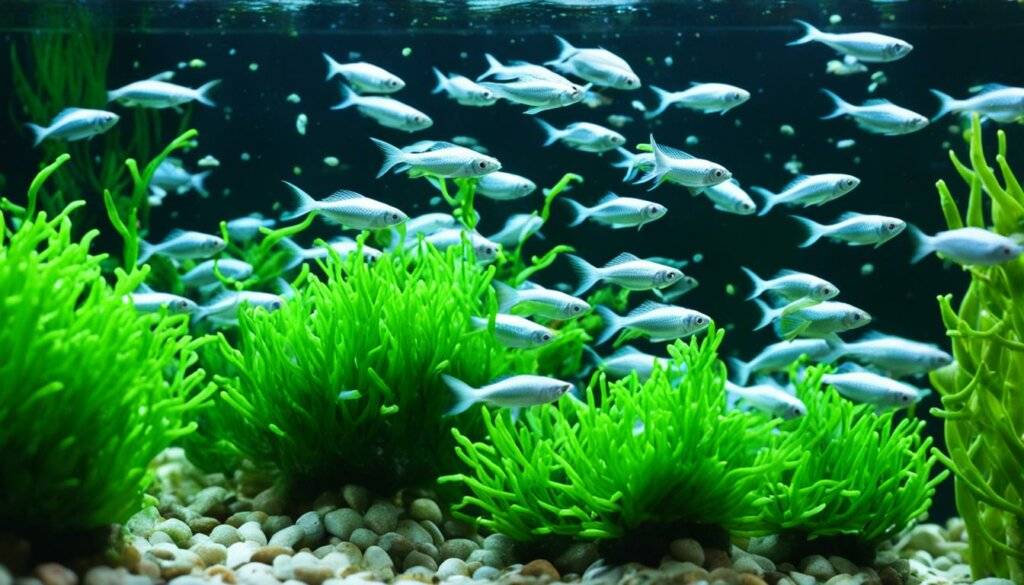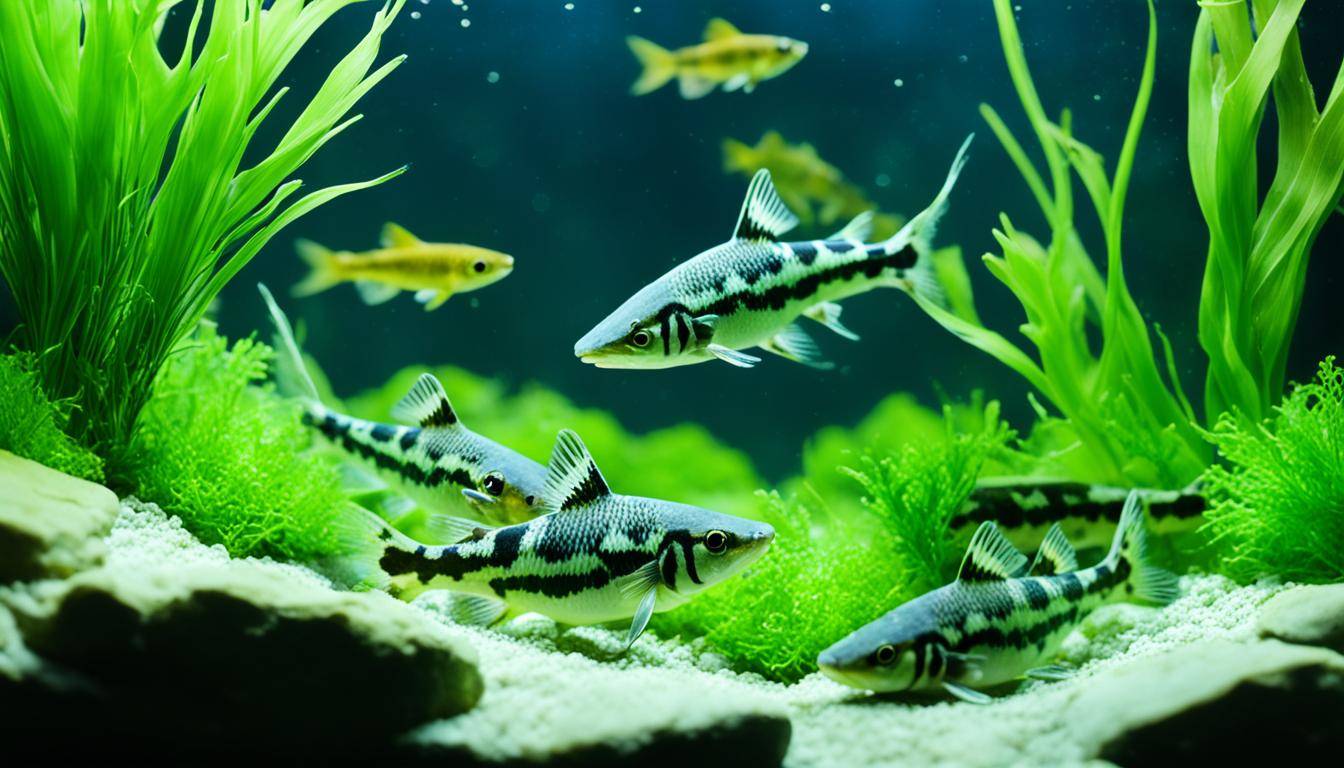If you’re a proud aquarium owner, maintaining a clean and visually appealing tank is likely one of your top priorities. Algae growth can quickly become a nuisance, affecting the aesthetics and overall health of your aquatic environment. That’s where otocinclus catfish come in. These small but mighty algae-eating fish are highly regarded by fish tank enthusiasts for their exceptional ability to keep algae growth in check while coexisting harmoniously with other tank inhabitants.
Key Takeaways:
- Otocinclus catfish are highly efficient in consuming algae and are a valuable asset to maintaining a clean and visually appealing tank.
- These catfish are peaceful in nature and can coexist harmoniously with other tank inhabitants.
- They are scientifically known as Otocinclus vestitus and are commonly recommended for their efficiency and effectiveness in maintaining a balanced aquarium.
- Adding otocinclus catfish to your tank can help control algae growth, improve water quality, and enhance the overall health of your aquatic environment.
- Ensure the tank parameters and provide a balanced diet to keep otocinclus catfish thriving.
The Benefits of Having Algae-Eating Fish in Your Tank.
Algae-eating fish, such as otocinclus catfish, offer several benefits to your aquarium. First and foremost, they help control the growth of algae in the tank, reducing its visibility and preventing it from becoming a nuisance. By consuming algae, these fish contribute to improved water quality by reducing excess nutrients and toxins released by algae.
They also serve as a form of natural filtration, breaking down algae and converting it into waste that can be processed by the tank’s biological filtration system. This helps maintain a clean and healthy environment for your aquatic pets. Additionally, the presence of algae-eating fish helps to increase the oxygen levels in the water by preventing dense algae growth. Adequate oxygenation is crucial for the well-being and vitality of all the aquatic life in the tank.
“The presence of algae-eating fish in your tank not only keeps it clean and visually appealing, but also contributes to the overall health and balance of your aquarium ecosystem.”
Overall, having algae-eating fish in your tank provides numerous benefits, from algae control to water quality improvement, natural filtration, and enhanced oxygenation. It is a valuable addition to any aquarium enthusiast’s maintenance routine.
| Benefits of Algae-Eating Fish in Your Tank |
|---|
| Controls algae growth |
| Improves water quality |
| Serves as natural filtration |
| Increases oxygen levels |
Otocinclus: The Ideal Algae Eater for Your Aquarium.
Otocinclus catfish are the perfect choice for keeping your aquarium clean and free from algae. With their voracious appetite for soft green algae, they effortlessly rid your tank of unwanted growth, especially on plants, glass surfaces, and other smooth areas. These catfish are particularly skilled at cleaning glass walls and plant leaves, ensuring a spotless and visually appealing environment in your aquarium.
Although otocinclus catfish primarily feed on soft green algae, they are versatile eaters and can also consume other types, such as brown diatoms. This versatility makes them highly efficient at maintaining a clean and algae-free environment in your aquarium. Say goodbye to unsightly green growth and hello to a pristine tank.
Adding to their appeal, otocinclus catfish are known for their peaceful nature. They can coexist harmoniously with a variety of tank mates, including shrimp, tetras, and rasboras. Their small size and non-aggressive behavior make them an excellent addition to community setups.
Whether you have a heavily planted tank or struggle with excessive algae growth, otocinclus catfish are the ideal algae eaters for your aquarium. Not only are they efficient at keeping your tank clean, but they also create a visually stunning and balanced aquatic environment.
How to Keep Otocinclus Catfish in Your Tank.
Keeping otocinclus catfish in your tank requires some specific considerations. To provide them with a suitable environment, you need to ensure their tank meets their requirements. Otocinclus catfish thrive in water with a pH of 7.2 to 7.5, GH of 8 to 16, KH of 4 to 7, TDS of 180 to 250, and a temperature of 70 to 74 degrees Fahrenheit. Creating the right tank parameters is essential, and adding Indian Almond or Guava leaves, Malaysian or Mopani wood, alder cones, and plants like Anubias and Swords can help create a conducive atmosphere for otocinclus catfish.
Providing your otocinclus catfish with a balanced diet is crucial for their overall well-being. You can meet their nutritional needs by feeding them a mixture of Northfin Veggie and Community foods, with Northfin Kelp Wafers serving as their main sustenance. This ensures they receive the necessary nutrients to thrive in your tank and maintain their health. By following these guidelines, you can create an optimal environment for otocinclus catfish in your aquarium.
Tank Parameters for Otocinclus Catfish
| Parameter | Ideal Range |
|---|---|
| pH | 7.2 to 7.5 |
| GH | 8 to 16 |
| KH | 4 to 7 |
| TDS | 180 to 250 |
| Temperature | 70 to 74°F |
Recommended Diet for Otocinclus Catfish
- Northfin Veggie and Community foods
- Northfin Kelp Wafers (main sustenance)
Creating the right tank parameters and providing a balanced diet will contribute to the overall health and well-being of your otocinclus catfish. With a well-maintained tank, you can enjoy the beauty and benefits of these efficient algae-eating catfish in your aquarium.
Tips for Selecting and Introducing Otocinclus Catfish to Your Tank.
When it comes to selecting and introducing otocinclus catfish to your tank, there are a few tips that can help ensure a successful and smooth integration. Here’s what you need to know:
Choose Healthy Individuals
It’s important to choose otocinclus catfish that are in good health. Look for individuals with round, pearly abdomens that are actively swimming and feeding in the tank. Avoid scrawny individuals that may have been starved of food for an extended period.
Timing is Key
When purchasing otocinclus catfish, timing is crucial. It is recommended to buy them soon after they arrive at the store, as they have likely been fasting and may not have eaten well for several weeks prior to your purchase.
Prepare Algae Availability
Before bringing otocinclus catfish home, ensure that you have plenty of algae available for them to feed on. This can be achieved by setting up a quarantine tank and allowing algae to grow for a week before introducing the otocinclus. The presence of ample algae will help the catfish settle into their new environment comfortably.
Balanced Diet
Offering otocinclus catfish a variety of foods is essential to ensure they have a balanced diet. While they primarily feed on algae, it’s beneficial to supplement their diet with other foods. Consider providing them with canned green beans, algae wafers, and blanched zucchini slices to meet their nutritional needs.
By following these tips, you can select healthy otocinclus catfish and introduce them to your tank successfully. Remember to provide them with algae-rich environments and a balanced diet to support their overall well-being.

-
Save
| Tips for Selecting and Introducing Otocinclus Catfish |
|---|
| Choose healthy individuals with round, pearly abdomens. |
| Purchase otocinclus catfish soon after they arrive at the store. |
| Prepare a quarantine tank with algae before introducing otocinclus catfish. |
| Offer a variety of foods to ensure a balanced diet. |
Other Algae-Eating Fish for Your Tank.
While otocinclus catfish are highly effective algae eaters, there are other fish species that also contribute to algae control in your tank. Here are a few options to consider:
Bristlenose Plecostomus: Also known as Bushynose Plecos, these small armored catfish have a sucker mouth and excellent algae-grazing abilities.
Siamese Algae Eaters: With their sleek bodies and distinctive black horizontal stripes, Siamese Algae Eaters are voracious algae eaters that consume various types of algae.
Nerite Snails: Although not fish, Nerite Snails are highly efficient algae eaters with a spiral shell. They consume algae on glass, rocks, and plant leaves.
Chinese Algae Eaters: Characterized by their torpedo-shaped body and golden coloration, Chinese Algae Eaters are popular algae-eating fish. However, it’s important to note that they can become aggressive as they mature.
When considering other algae-eating fish for your tank, it’s essential to research their compatibility with your existing tank mates and their specific dietary requirements.

-
Save
| Fish Species | Description |
|---|---|
| Bristlenose Plecostomus | Small armored catfish with a sucker mouth. Excellent algae-grazing abilities. |
| Siamese Algae Eaters | Sleek bodies with distinctive black horizontal stripes. Voracious algae eaters. |
| Nerite Snails | Highly efficient algae eaters with a spiral shell. Consume algae on glass, rocks, and plant leaves. |
| Chinese Algae Eaters | Torpedo-shaped body with golden coloration. Popular algae-eating fish. Can become aggressive as they mature. |
Conclusion
Adding otocinclus catfish or other algae-eating fish to your tank can be a game-changer for maintaining a healthy and visually appealing aquarium. These fish play a crucial role in reducing algae growth and improving water quality through their efficient algae-consuming abilities. By keeping otocinclus catfish in your tank, you can enjoy the benefits of natural filtration and increased oxygenation, ultimately creating a well-balanced ecosystem for your aquatic inhabitants.
When selecting and introducing otocinclus catfish to your tank, follow the tips provided to ensure their successful integration and longevity. Consider other algae-eating fish species like Bristlenose Plecostomus, Siamese Algae Eaters, Nerite Snails, and Chinese Algae Eaters for enhanced algae control. By maintaining a diverse community of algae-eating fish, you can significantly minimize the need for manual tank maintenance and keep algae growth in check.
Remember, a healthy tank requires proper maintenance. Regular water changes, maintaining appropriate water parameters, and providing a nutritious diet for your fish are crucial for their overall well-being. By incorporating otocinclus catfish and other algae-eating fish into your tank, you can make tank maintenance more manageable and enjoy the beauty of a well-maintained aquarium.
